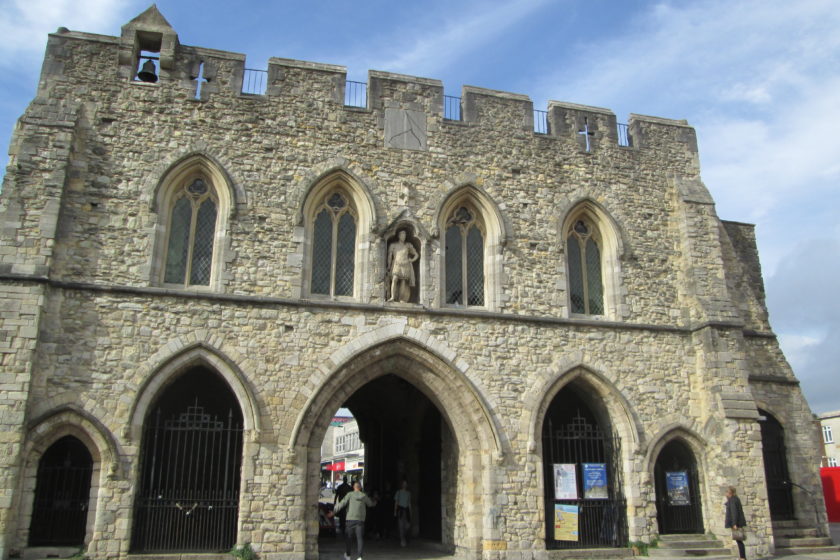
Steve and I were blessed to experience the unlikely fulfillment of a longstanding dream
this summer. I say “dream” because it was too lofty to be a “bucket list” item that we set out to
do sometime in our life; it was something that existed only in our wildest imaginations. We made
a crossing of the North Atlantic on the Queen Mary 2!
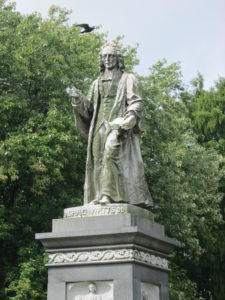
I have been in love with the sea and ships since my earliest ferry boat rides from my
childhood home in Seattle to the Olympic Peninsula and the various islands in Puget Sound.
Later, on a visit to Seattle in my teens, I got to take the ferry all the way to Vancouver Island, a
journey of several hours. When I was in second grade, we had moved to the Midwest, but I still
got to enjoy the sight of ocean-going ships and majestic lighthouses on Lake Superior when we
would go to visit my grandmother in Duluth. However, when I settled as a newlywed, for what
would be the next 40 years of my life, in land-locked Colorado, my only regular connection to
the sea would be my husband’s collection of oil paintings that the family calls “Dad’s ship
pictures.”
In our 40 years of marriage we have gone on many boat rides– mostly short river or
harbor excursions– but we have never even been on a cruise. It was almost beyond our
imagination to travel for a week on the last “floating palace” on the Atlantic. When an affordable
opportunity came to make the crossing with long-time friends, now family, Keith and Laurie
Wishart, we didn’t just jump at the chance; we jumped up and down at the chance!
I will write more about our ship time later, but for now I will summarize it in my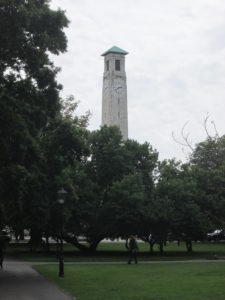
husband’s words, “It was the best of both worlds!” We experienced all of the physical luxuries
and pleasures of being treated like “spoiled bairns” by a wonderful Cunard staff from all over the
world; and, we had daily spiritual blessings as God brought us into sweet and meaningful
fellowship with other Christians on board, and as He showed us new insights from Scripture
about the sea
This blog is focused on the beginning of our journey in Southampton, England.
In the providence of God, certain locations come to have strong associations with certain
of God’s choice saints, for example, Kidderminster with Richard Baxter, Bristol with George
Mueller, Edinburgh with John Knox, Northampton with Jonathan Edwards. Because the church
of Jesus Christ is being assembled from all nations, tongues, and tribes, across all time, I find
myself drawn to such places for the “mystic sweet communion with those whose rest is won,” as
hymnwriter Samuel J. Stone wrote. Such is the connection between Southampton, England and
Dr. Isaac Watts.
Watts was born in Southampton in 1674, 54 years after the Mayflower pilgrims sailed
from there. He was the son of Isaac and Sarah Taunton Watts. The elder Watts was a member of
an independent (i.e. non-Anglican) congregation that often was forced to meet in secret during
times of heightened persecution. Despite their best efforts at discretion, many dissenters were
jailed during the 17 century for not participating in the state-authorized Anglican church. th
Between the years 1662 (the end of the Interregnum) and 1688 (the Bloodless Revolution),
religious freedom and toleration came and went, then came and went again and again, at irregular
and uncertain intervals. Because of his Biblical religious convictions, the elder Isaac Watts was
imprisoned in God’s House Tower prison numerous times, including during the months when the
younger Isaac was a newborn infant.
In spite of the frequent persecutions, the dissenting congregations in Southampton were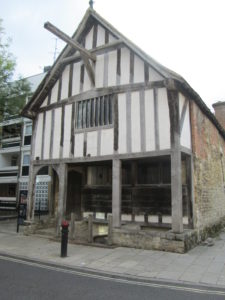
strong and faithful. So was the elder Watts in his household. He trained all of his children well in
Scripture knowledge, and set a fine example of faithfulness through regular family worship. The
younger Isaac was impressed with a deep love of God as he too came to know the Savior that his
father was willing to suffer for. Because of this early training, the younger Isaac identified with
the “dissenters” throughout his life, even turning down a prestigious scholarship to Anglican
Oxford or Cambridge.
The younger Isaac, or Dr. Watts, as I will now call him, was a brilliant young man. He
excelled in all of his studies, and studied under some of the best teachers of the day, even though
he chose to attend a small, “underground,” dissenters’ academy. He is best remembered today for
a number of well-known hymns, such as “When I Survey the Wondrous Cross,” “O God, Our
Help in Ages Past,” and “Joy to the World.” However, he was also the author of valued texts on
education, logic, grammar, songs and poems for children, books on astronomy and geography,
philosophical and theological essays, plus many sermons. One of the greatest literary critics, Dr.
Samuel Johnson, thought so highly of Watts’ Improvement of the Mind, that he quoted it
extensively in his famous dictionary.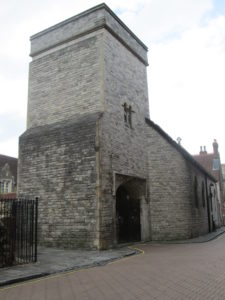
In addition to all of the scholarly writing he did, Dr. Watts was a pastor, a tutor, an
educational advisor, and a benefactor of the Great Awakening in America. In spite of having very
weak health for most of his life, Dr. Watts used every possible moment and every bit of strength
to the greatest effect during his 74 years on earth.
One of his contemporaries and a fellow educator, Dr. Philip Doddridge, said,
“I congratulate you, dear sir, while you are in a multitude of families and schools of the
lower class, condescending to the humble yet important work of forming infant minds to
the first rudiments of religious knowledge, and devout impressions, by your various
catechisms and songs, you are also daily reading lectures of logic and other useful
branches of philosophy to studious youth; and this not only in private academies but in
the most public and celebrated seats of learning, not merely in Scotland, or in our
American colonies, …but, in our English universities. I too congratulate you that you are
teaching no doubt hundreds of ministers and private Christians by your sermons… But
above all I congratulate you that by your sacred poetry, especially by your psalms and
hymns, you are leading the worship, and, I trust also, animating the devotions of
myriads…” [quoted in Isaac Watts Remembered]
Steve and I spent four days in Southampton before our crossing. The old city center is
little changed from Watts’ time in terms of the layout of the streets, though many old sites were
destroyed during World War II. High Street still runs from the town quay up to the Bar Gate, the
northern entrance into the old walled medieval town. The Bar Gate is only a few yards from
where the Above Bar Congregational Church met in a building that was on property leased from
the Watts family. Portions of the ancient walls are still standing here and there, and a handful of
buildings and ruins that Watts would have seen have been preserved, including God’s House
Tower prison.
We walked through the area from Watts Park on Above Bar Street down to harbor, as the
Watts family would have done so often in their lifetime. The old town is a little tired looking
nowadays, since the town has declined in importance as a seaport. But the town in Watts’ day
was also a tired shadow of its former self after the Great Plague in 1665. Nonetheless, it is on a
beautiful piece of land where two rivers flow into the Solent, the body of water between the coast
of mainland England and the Isle of Wight. The New Forest is across the water to the west.
Though Watts spent most of his adult life in the suburbs of London, he returned several times to
Southampton to visit. The beautiful scenes around his hometown inspired some of Watts’ many
verses that were written during times he was at home with his family.
A large part of the activity of the city at the present time is related to colleges and
university programs in Southampton, though the education now would not compare favorably
with the dissenters’ academies of Dr. Watts’ time. One experience that did compare favorably for
us, however, was attending the small evangelical, “dissenters’” church, Springhill Evangelical
Church. We were able to attend Sunday worship there during our stay in town. Our fellowship
was sweet and we were capably fed on God’s Word by a visiting preacher. A special highlight
was meeting Mrs. Frances Fountain, the widow of David Fountain (the author of my favorite
book on Isaac Watts). I quickly produced the book out of my handbag for her to sign, even
though I did not know about the connection with that church beforehand.
During our time at sea after leaving Southampton, many sights brought some of Isaac
Watts’ most familiar words to life in a special way. I’ll share some of them with you here.
I sing the mighty power of God
That made the mountains rise,
That spread the flowing seas abroad,
And built the lofty skies.
I sing the wisdom that ordained
The sun to rule the day;
The moon shines full at His command,
And all the stars obey.
There’s not a plant or flower below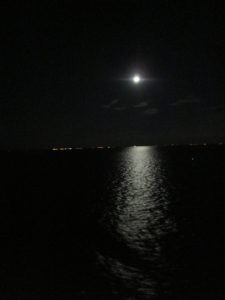
But makes His glories known;
And clouds arise and tempests blow
By order from Thy throne;
While all that borrows life from Thee
Is ever in Thy care,
And everywhere that man can be,
Thou, God, art present there.
– Isaac Watts, 1674-1748
References:
Fountain, David. Isaac Watts Remembered. (Southampton: Mayflower Christian
Bookshop, 1998 ed.), p. 80
Watts, Isaac. “I Sing the Mighty Power of God.” Great Hymns of the Faith. (Grand
Rapids, Michigan: Singspiration Music, 1968)